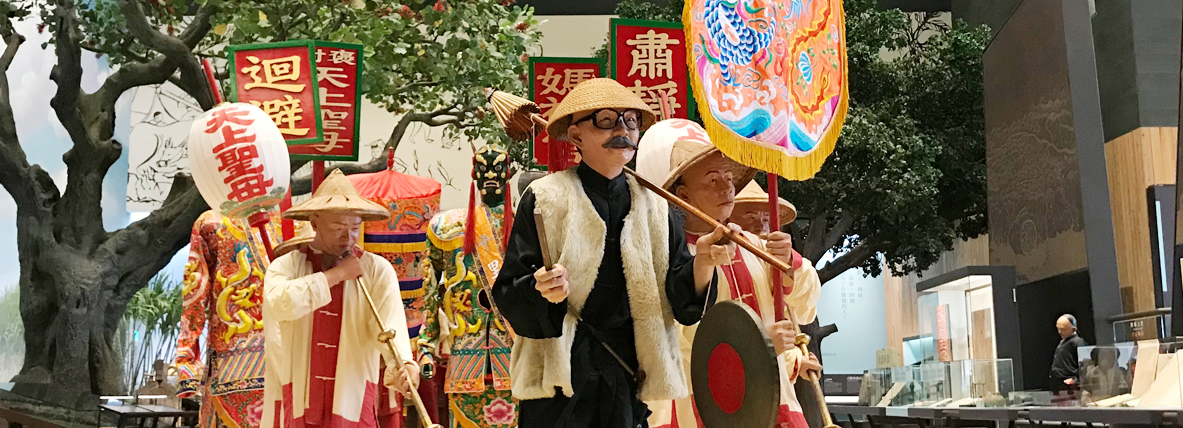:::




Theme
Taiwanese

Before the focus of history was turned upon the island, people were already living in Taiwan, and these have left many traces of their lifestyles. Four centuries ago, the indigenous people were the original inhabitants of Taiwan, and the Dutch, Spanish, Han Chinese and Japanese were guests, with some being passing visitors, while some remained to establish their roots here. Two centuries ago, many Han Chinese people risked the official maritime embargo and the danger of crossing the stormy waters of the Taiwan Strait, with some being illegal immigrants and others sent to the island by the government. One hundred and fifty years ago, many Han Chinese came to Taiwan and chose to stay in because of economic incentives, due to the rising trade in tea, rice and camphor, and eventually their descendants saw the island as their home.
One hundred and ten years ago, the Japanese came to Taiwan, making it their first colony, introducing post-Meiji Restoration systems and measures. Eight decades ago, Taiwanese people, having received a modern education, began calling for democracy and greater rights, and these were the pioneers of later democratic movements in Taiwan. After 1945, many Han Chinese retreated to Taiwan from China with the ROC Government, in turn creating a military village culture on the island. Over the last 20 years, many foreigners have married Taiwanese citizens, thus becoming important members of the growing family on this island.
The people living here are not differentiated by ethnicity or gender, only by the order in which they arrived, because anyone who recognizes Taiwan is deemed to be Taiwanese.
Architecture

The spatial arrangement and functionality of architecture reflect society’s control over space. Its structure and technology represent humanity’s knowledge and interpretation of science, as well as adaptation to the environment. Its presentation embodies aesthetics based on the foundations of the two aforementioned elements, and it is also a concrete characterization of human civilization.
If architecture is said to be the culmination of culture and history in human society, thus embodying contemporary thinking and aesthetics, then on an island with such a diverse culture and many ethnic group, there must be an architecture that can reflect the rich history of Taiwan. In response to living, industrial, religious, political and military needs, our ancestors, the indigenous people, the Dutch, Spanish, Han Chinese and Japanese, constructed many buildings by employing different identities, perspectives, materials and technologies. Some of these have become historic buildings and monuments, while others are gradually disappearing.
The various forms of architecture built by different people at different times were designed to fulfill various needs, and thus they many have single or multiple functions, their structures may be simple or complex, and their styles may be rustic or extravagant. As though frozen in space, architecture enables people to appreciate the different stages of history in Taiwan.
Transportation

The Ice Age caused the sea level to drop, and many animals were thus able to walk to Taiwan from the East Asian continent. As the sea level rose with the melting of the ice, it created the sea routes that eventually enabled the Dutch and Spanish to come to Taiwan on sailboats in the 17th century, in turn introducing new perspectives on the island. Through maps from this time and models of boats, we will be able to travel through the vast sea of history and see Taiwan’s position in the world.
In addition, we can also observe the interactions between exotic cultures during this period, as well as how the island of Taiwan managed to makes its path to the world by taking advantage of its marine resources. The complex terrain of Taiwan, comprising mountains and rivers, is imprinted in history in the form of maps, sketches and books, produced to aid colonization, trade, or missionary work. These give details of the difficulties faced when travelling on the island prior to the 20th century. Nowadays, with the use of railroads, highways, and planes, it is possible to travel to and from Taipei and Kaohsiung in one day.
The driving forces propelling Taiwan forward in the river of history are sails in the tall wind, hard-working people and relentlessly turning wheels.
Religion

Faith is the collective spiritual activity of humanity, which has undergone many transformations and transitions in the long history of mankind. Its diverse and varied appearances are influenced by various cultural and ecological environments.
Prehistoric people in Taiwan left signs of religion as early as the Neolithic Period, after which the indigenous people and Han Chinese settlers all developed rich and diverse religious forms. Influenced by historic elements and interactions among various ethnic groups, different religions expanded, mingled or transformed. After the 17th century, the religious beliefs of the indigenous people, missionaries and Han Chinese came together, and the development of religion was significantly affected by national policies during the Japanese era.
Folk religion in Taiwan is diverse and vivacious life force that is intimately related to the everyday lives of the public. From a spatial point of view, temples are more than venues for religious worship, as they are also sites for social cohesion. In a household, the main hall is the all-important center of religion. Furthermore, some religious activities will change over time, while certain rituals are passed down from generation to generation. These include, for example, the traditions of celebrating by setting up incense burning tables, making sacrificial offerings during deity parades or pilgrimages, or the folk dance performances held during God welcoming ceremonies.
Religion provides people with spiritual sustenance, and something on which they can depend on when seeking solace. Now, let us contemplate the intangible spiritual power by admiring the tangible exhibits.






